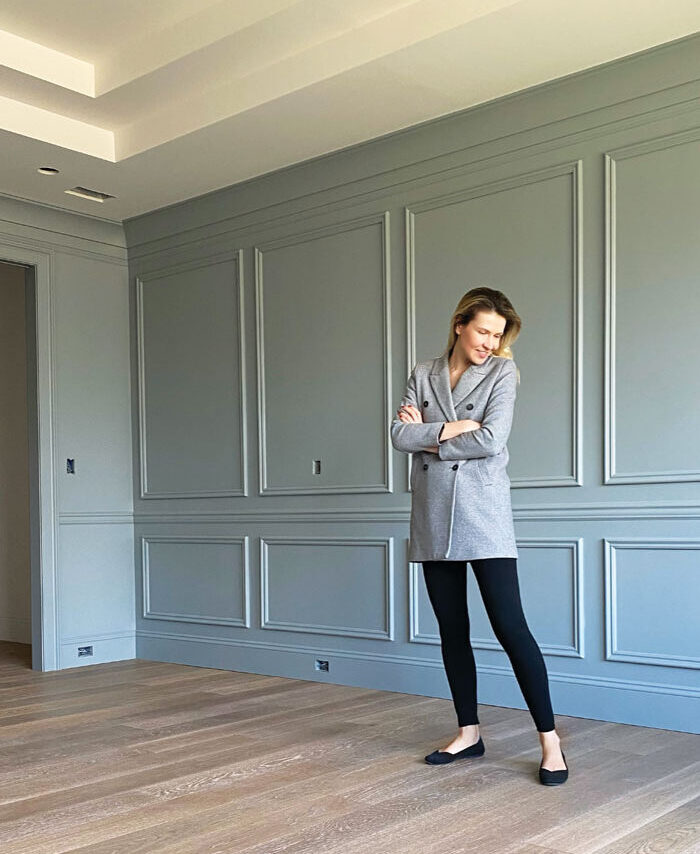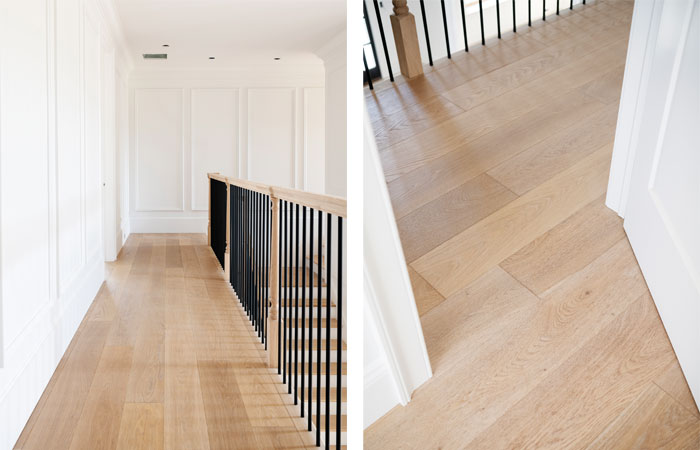Conversations with Kate: Facts About Flooring
| Photographer Tori Sikkema | Interview by Ren Miller |Furnishings often get the most attention, but what’s underneath it all matters too.

Kate chose engineered wood flooring with a finish she calls “interesting, complex, deep, sophisticated, buttery and velvety.”
Hardwood flooring dates back to the 1600s, when unfinished boards were placed on joists over dirt or stone. By 1625, wood flooring artisans were creating patterns by cutting and piecing together different shapes in techniques called parquetry and marquetry. The wood was scraped by hand, rubbed with sand, stained and polished. Today, 400 years later, techniques have advanced to the point where you can choose engineered wood flooring that is precut, prefinished and ready to install to create a solid, fashionable and timeless look. Kate Rumson, founder and creative director of The Real Houses of Instagram (@the_real_houses_of_ig) explains why she chose engineered wood flooring for the home she is building in central New Jersey, a project that Design NJ has been following in this column.
REN: In your new home did you use wood throughout or only in certain areas?
KATE: I chose wood for the entire house. I don’t love seeing transition strips or seams between two types of flooring, so I usually use the same material (wood in most cases) throughout the house, except for bathrooms.
REN: Did you choose engineered or solid wood floors?
KATE: I always choose engineered wood floors because I like the look of wider floorboards (in this case, 7½ inches wide), and engineered wood offers a lot more options in various widths. I also prefer engineered wood flooring because it doesn’t expand and contract to the same extent as solid wood, and it looks the same years after installation. Solid wood floors finished on site look virtually seamless when they’re first installed, but quite often they begin to develop fine but visible seams between boards a few years later.
REN: Were your floors prefinished or finished on site?
KATE: I gravitate toward complex wood finishes and love texture on my wood floors, so it would be very difficult to create my perfect floor finish on site. The floor I chose for my new house is made by Duchateau in an exclusive finish called Lugano. It has the most beautiful, interesting, complex, deep, sophisticated, buttery and velvety color and finish that, to me, cannot compare to anything I’ve ever seen finished on site.
REN: When using prefinished, engineered wood floors, should the baseboards be installed before or after the flooring is down?
KATE: There’s no right or wrong way; every builder does it differently, but I prefer to install floors after baseboards. I like to have the entire room finished and painted first to avoid potentially damaging the new floors when installing baseboards or painting. I always ask my millwork contractor to install the baseboards raised off the subfloor by a hair more than the thickness of the wood floor. This way the floor installers can slide the wood floors under baseboards and there will be no need for shoe molding.

To avoid construction damage to wood floors, she recommends installing them last. At her new home, the baseboards were raised off the subfloor by a hair more than the thickness of the wood flooring, which was then slipped under at the end. Using the same flooring material throughout a home helps to avoid unseemly seams.
REN: Is it possible to match a staircase to prefinished wood floors?
KATE: Absolutely! My flooring contractor (J. Rapaport Wood Flooring) created a few different sample boards with custom stain options to find the perfect match. I recommend leaving this to experienced flooring contractors as they know what products and stains to use with different wood species to achieve the desired color.
REN: In the kitchen, which goes in first: the flooring or the cabinetry?
KATE: I would never install prefinished wood floors in the beginning of construction (before kitchen cabinets) because I wouldn’t want to risk damaging my new floors in the months ahead when the house will be full of contractors using sharp and heavy tools, painting, installing cabinetry, and getting deliveries of heavy building materials, appliances and countertops. Even if everyone tries their best to be careful, accidents do happen. Yes, there is floor protection, but high-quality temporary floor protection will cost more than $10,000, and it still won’t protect your floors if a water pipe bursts while the house is under construction. Why add all this unnecessary stress of worrying about water pipes or someone dropping or spilling something when wood floors can be installed at the very end of construction?
